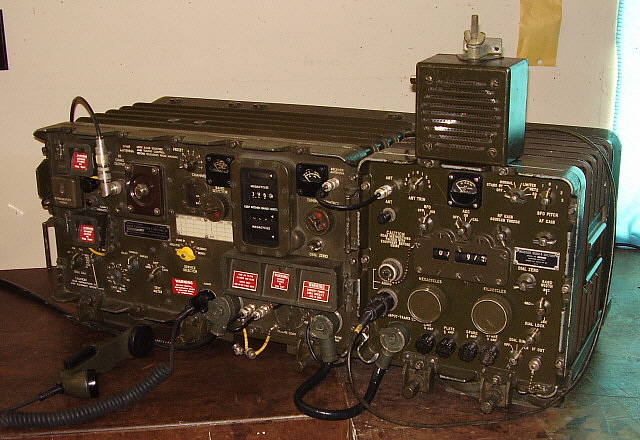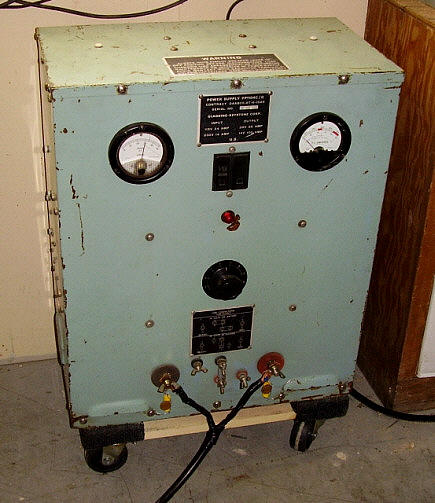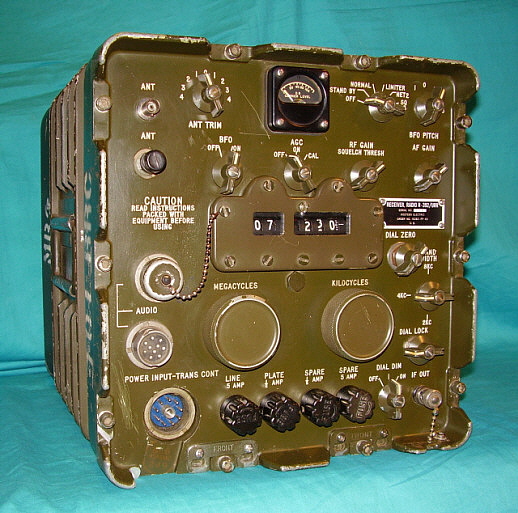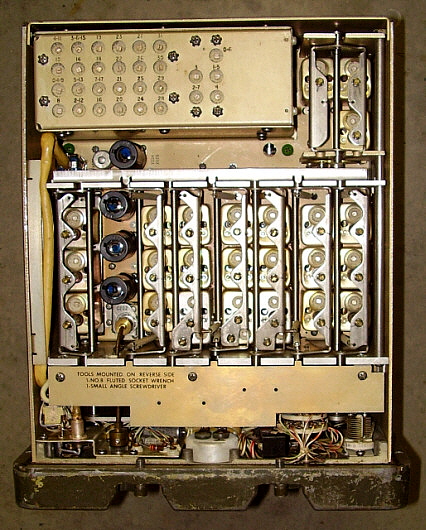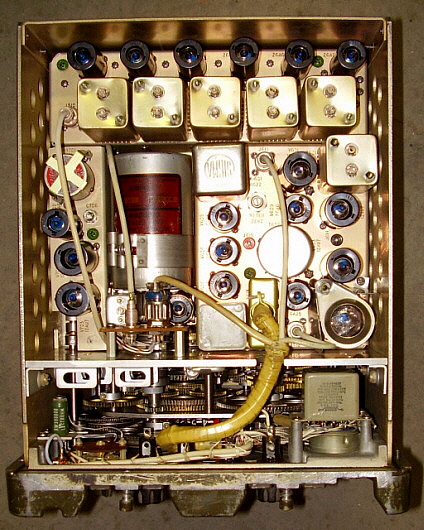| Power Cable Suggestions
- To operate the GRC-19 requires a hefty power supply capable of
+28.5vdc at 40 amps - 50 amps is better. Later versions with the solid
state +HV dynamotor replacement power supply will operate at about 32
amps. This is "key down" with voice peaks driving the current
requirements slightly higher. I use a PP-1104 power supply and have no
problems with current requirements. If you have to build a power cable
for your GRC-19, be sure to make the cable shielded. The original cable
was an eight gauge inner conductor that was the positive and the shield
was the negative with the cable length being ten feet. I use a nine foot
length of shielded cable that consists of two ten gauge wires and two 14
gauge wires. I tied the two 10 gauge wires together for the positive and
tied the two 14 gauge wires along with the shield for the negative. This
cable works quite well. If you have to make the cable I would use two
eight gauge wires and then use the braided shield removed from old RG-8
coax to make the cable shielded.
Use a Headset for Comfort
- To say that the GRC-19 is a rather noisy transmitter-receiver
combination is a real understatement. If you use the LS-166 loudspeaker
with the R-392, you will have to have the Audio Gain at least 75%
advanced to hear any stations. Forget hearing weak stations. The LS-166
isn't a very good speaker anyway since it was mainly designed to be
weather proof. The most comfortable operation is gained by operating the
R-392 with a headset with cushions that completely seal the ears. I use
the H-301 headset with an extension cable that I replaced the
PL-55 plug with a UG-77 plug for interfacing with the R-392. This allows
me to reduce the Audio Gain down to 10% advanced or so. Additionally,
the noise from the T-195 is greatly attenuated by the cushions on the
headset. It really makes operating the GRC-19 about as comfortable as
possible.
Initial Tune-up on an Antenna
- If you are going to use an Inverted Vee fed with 50Z ohm coax then
your antenna load to the T-195 is somewhat dependent on your frequency
of operation. If you stay around the AM-MIL frequencies, then the T-195
autotune will easily match to the load since it will be around 50 Z
ohms. If you're like me and operate a Tunable Inverted Vee then the
initial set-up will require a little pre-testing. My antenna is a 135 ft
Inverted Vee antenna fed with 78 ft of ladder line going to a small 275W
Johnson Matchbox. Initially, when determining where to set the Matchbox
to provide a 50 Z ohm antenna load, I used a Viking Ranger to experiment
with what Matchbox settings provided a 1:1 match. Of course, any
convenient-to-use transmitter will work. I used a Drake inline W-4
wattmeter and adjusted the Matchbox for minimum reflected power. Once I
knew where the Matchbox needed to be set at specific operating
frequencies, I logged these settings down and then I was ready to switch
over to the T-195. Since I'm setting the antenna/Matchbox combo for 50 Z
ohms, the T-195 will auto tune to match that 50 Z ohm load. Before hand,
I had the T-195 loading into a 50 ohm dummy load therefore there should
be very little auto tuning that needs to occur. You will have some
slight autotune action since the antenna/Matchbox combo has some
reactance that isn't in the dummy load but the autotune loading should
only take a few seconds. If everything is set correctly, you'll have
very little reflected power and the T-195 will be running over 100 watts
output "key down." You can make very small adjustments to the Matchbox
but go slow. Too much change shows up as an error voltage in the
discriminators of the T-195 and it begins to autotune to compensate. If
you make very small changes (slowly) you should be able to "null" the
reflected power. Any antenna/tuner setup should work approximately the
same way with the GRC-19, that is, find your antenna tuner settings for
a 50 Z ohm load first using a regular ham transmitter and then switch
over to the GRC-19.
Microphone Critiques
- The "Pork Chop" microphone, the M-29, is a terrible microphone. The
M-51 plug-in element (used in the M-29) is awful and even "NOS - in a
sealed package" examples won't have much response. I don't know if there
were ever any M-29s that worked okay but today it seems like they are
all non-responsive and sound terrible if they happen to work. If you find that your Modulation
Level on the T-195 is set to about 80% advanced that's usually an
indication that it was being used with the M-29. They sound okay
(generous statement) with
the Mod Level set high but you can't switch to any other kind of mike
since all of the other types will require the Mod Level to be around 50%
to 60%
advanced (with the Clipping set to zero.)
The H-33 handset mike is better sounding but it depends on the mike's
condition and to a certain extent on when it was made. Earlier ones
(made in the USA) seem
to have better quality but that could be just the examples I've seen and
heard. Later Euro-built versions sound nasal-like with very restricted
audio. It might be because the later H-33 were designed for SSB. At any
rate the Euro ones sound pretty bad on AM. By the way, don't listen to
the R-392 using the H-33 handset as the quality is pretty bad - a
headset is much better since you will eliminate (or greatly reduce) the
T-195 blower noise. The best sounding, stock mikes that I've
tried so far are Audio Sears and Electrospace Corp. versions of the H-33.
When using the H-33, I usually will listen during the net using the
H-301 headset but when my turn comes to transmit, I take off the headset
and use the H-33 handset. After I finish my transmission I then return
to using the headset. Kind of a hassle but the audio using the H-301
headset makes it worth it.
Microphone
UPDATE 2016:
Let's face it, the M-29 and the H-33 are not the greatest for
microphones. Although the H-33 is better, it's still "rough" sounding at
best. I recently heard W1NZR on his GRC-19 and was amazed at his audio
quality. Natural sounding with good communications sound. I asked Brown
how he achieved such great audio on a T-195. He responded that it was
the microphone. He was using one of those Motorola dynamic mikes that
have the built-in pre-amp. They were used on a lot of Motorola radio
gear in the late-1950s and thru the 1960s (we've all seen them, they're
the really ugly ones that Motorola made.) Brown was operating the
pre-amp board from the carbon mike bias line and then running the
dynamic mike down stream of the carbon mike bias blocking capacitor.
Also, Brown had bypassed the Clipper of the T-195. The result was very
clean audio that sounded very natural and had a communications bandwidth
to it.
Another Microphone Suggestion
2019 - A few years ago I made up a carbon mike for the T-368
transmitter. It uses the same type of UG-77 connector as the T-195. This
mike was sort of a "custom job" in that I used a Shure 102-C body, PTT
switch and cable but I removed the Shure element. I replaced the old
element with a NOS element from a surplus Chi-Comm mike that was a
Vietnam-era, Shure look-alike. These mikes used to be available on eBay
from various dealers in Chinese military surplus. The mike body is junk
but the element is first-class and has plenty of response. The Chi-Comm
mike element easily fits into the Shure 102-C body. I used the mike once
or twice on the T-368 but went to an amplified TUG-8 stand with D-104
head for that transmitter. The Chi-Comm 102-C just sat around until I
was retesting the GRC-19 set up for this season. The HS-33 sounded okay
but a little anemic audio-wise. I happened to see the old Chi-Comm 102-C
and saw that it had the UG-77 plug installed. I checked the schematics
to be sure they were interchangeable and then gave it a try. Lots of
response with a full sound to the audio. Now, this mike isn't noise
cancelling so I was expecting a lot of blower noise but that wasn't the
case. I held the mike about 3" from my mouth and when talking, no blower
noise could be heard. Of course, without any speaking, you'll hear the
blowers but not when speaking. I got good audio reports from other
military radio users on the West Coast MRCG net. These Chi-Comm mike
elements might take a little looking to find but they do show up once in
a while on
eBay. They look like a typical Shure handheld mike but painted olive
drab.
Another Microphone Suggestion -
2022 - The GRC-19 is located out in the shop. The
temperatures in the shop are always cold unless it's the middle of
summer. Trying to use the GRC-19 during winter in shop, with the blowers
going right in your face, is pretty uncomfortable. So, why sit directly
in front of the GRC-19? I rigged up a longer microphone cable which now
allows me to sit a few feet to the side of the GRC-19. A lot quieter and
a lot better in the winter.
Utilizing the 600Z ohm Line
- The T-195 provides a 600Z ohm line that connects directly to the HP
filter putting it on the "down stream" side of the carbon mike coupling
capacitor. This 600Z input was provided for RELAY operation where the
radio operator was receiving a signal on the R-392 on a separate antenna
and on a different frequency. With the T-195 switch in the RELAY
position, that incoming signal was then routed from the R-392 output via
pin A on the T/R interconnect cable connector to the T-195 600 Z ohm
line input that is on pin A of the AUDIO connector. Before being routed
to the Speech Amplifier section of the Modulator module, the line is
routed through a gain control that is marked "LINE LEVEL - DBM" on the
front panel. As the radio operator was receiving the signal on the
R-392, he would adjust the LINE LEVEL control for proper modulation
levels on the T-195. Naturally, the T-195 was operating on its own
antenna and on a different frequency than the incoming signal on the
R-392. This allowed the radio operator to receive an important signal
from say a low power field transmitter that had limited range and then
"relay" that signal to the proper receiving station using the higher
power available from the T-195 (and probably better antenna set up.)
It's possible to disconnect the R-392 audio output at the T/R
interconnect cable by removing the wire connecting to pin A. Then it's
possible to connect an amplified mike base (like the TUG-8) with a
crystal mike head using a UG-77 connector with the mike connected to pin
A rather than pin C. Ground and PTT remain the same connections. Switch
to RELAY position on the T-195. Now you
will be able to use the LINE LEVEL control to adjust the modulation
level for the amplified mike. This allows you to run a crystal or
dynamic mike with the T-195 with only a very slight modification to the
T/R interconnect cable (and that can be returned to stock at anytime.)
Unfortunately, nearly all crystal and dynamic mike heads will be of
the type that are NOT noise cancelling. You might find that the blower
noise from the T-195 is over-powering. Close-talking the mike will help
but that sort of defeats the audio improvement gained by this change.
It's worth a try though because the modification
is so simple and so easy to return to stock if desired. See "Another
Microphone Suggestion 2019" above regarding no blower noise using a
non-restrictive mike.
It should be possible to use a hand-held dynamic mike that has a 500Z
ohm load on the 600Z ohm line.
Always Use a 'Scope
- When operating "on the air" you should always have a monitor for
watching carrier level and modulation level. Any oscilloscope can
function as a monitor by connecting a three foot long "pick up" wire to
one of the 'scope's vertical amplifier's input. Set the time base
(sweep) to whatever gives a good representation of the wave envelope.
With this easy set up you can immediately see the modulation level and
what the audio waveform looks like. It's also helpful when the T-195 is
autotuning to watch the carrier level on the 'scope. As the T-195 "zeros
in" on resonance, you'll see the wave envelope increase until the
transmitter is at full output. Also, it's helpful to have a digital
frequency counter with a "pick up" wire to monitor frequency. The
T-195's mechanical digital frequency readout is very accurate but it's
nice to have confirmation of the transmitter's frequency.
CW Operation - If
you can find someone else interested in military radio CW, the GRC-19
does CW without too many problems. Probably the most difficult problem
is installing the UG-77 connector on a cable end so you can "plug in"
the key. Another oddity is that you can input the key using one of the
spare AUDIO connectors on the R-392. Pin F is the keying line and it is
pin F on all of the AUDIO marked connectors including the one on the
T-195 and the two on the R-392. Pin F is worked against pin H which is
ground on all AUDIO connectors. Since the mike is usually going to be on
the T-195 AUDIO connector and the H-301 headset is on one of the AUDIO
connectors of the R-392, that leaves just the other R-392 AUDIO
connector for the CW key input. The CW key referenced in the manual is
the KY-116/U which is a "leg key," that is, the key assembly clamps onto
your leg for sending without a table. However, if a table is available
the key platform hinges back and the key will set nicely on a table for
sending that way too. I've used the leg method and actually it's not
bad. Much easier than one would expect. With the leg key you can lean
back in your chair, relax and send with your arm in a downward position.
Very comfortable.
Operate on the Amateur Military
Nets - As with most military transmitters, the T-195/GRC-19
will have to be operated on amateur military radio nets where the
participants are familiar with the sound of carbon mikes and the typical
restricted audio of later military transmitters. Since the modulator
module has filters that limit the frequency response to 300hz to 3500hz
and, on top of that, there is a limiter in audio section (and you're
probably using a carbon mike,) if you operate on a regular AM net,
you're very likely to receive several "critical audio reports" from the
"broadcast audio" crowd. The T-195 isn't a broadcast transmitter.
It's an electro-mechanically complex, completely autotuning, portable
military transmitter that runs a respectable carrier level power output.
Stay on the military radio nets and your T-195/GRC-19 will be
appreciated for it's unique sound, powerful signal and for the rarity of
hearing an operating example "on the air." |

